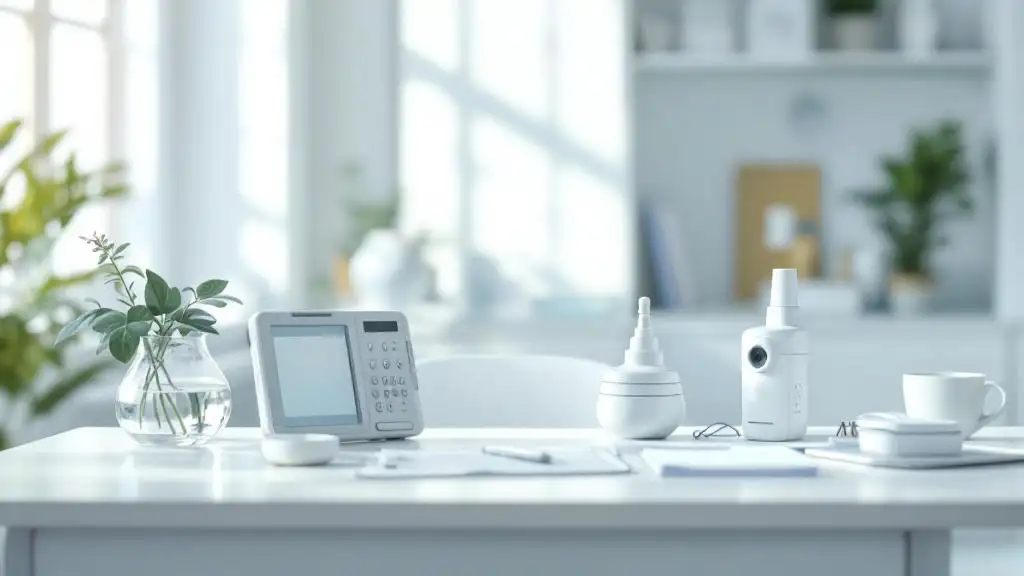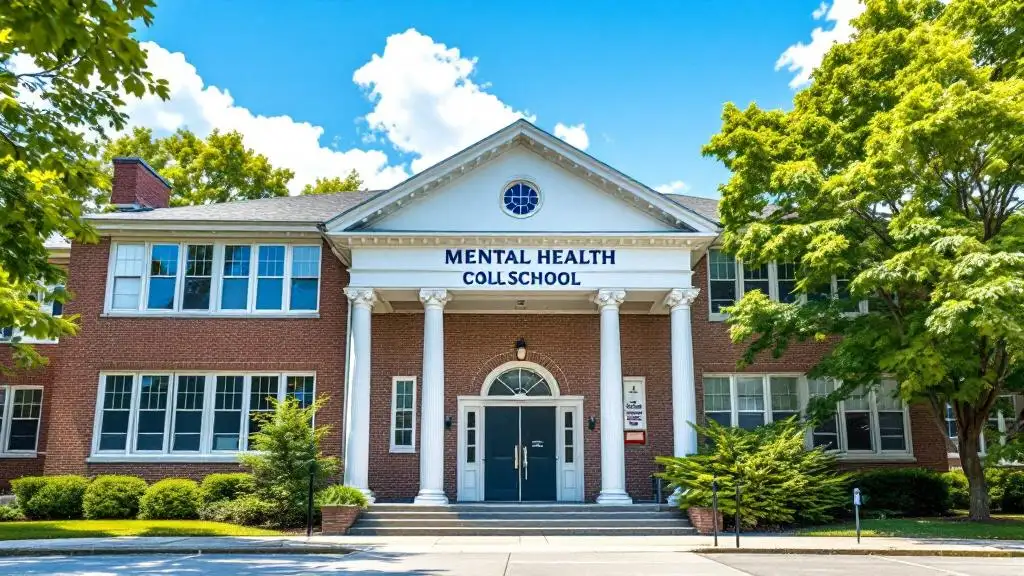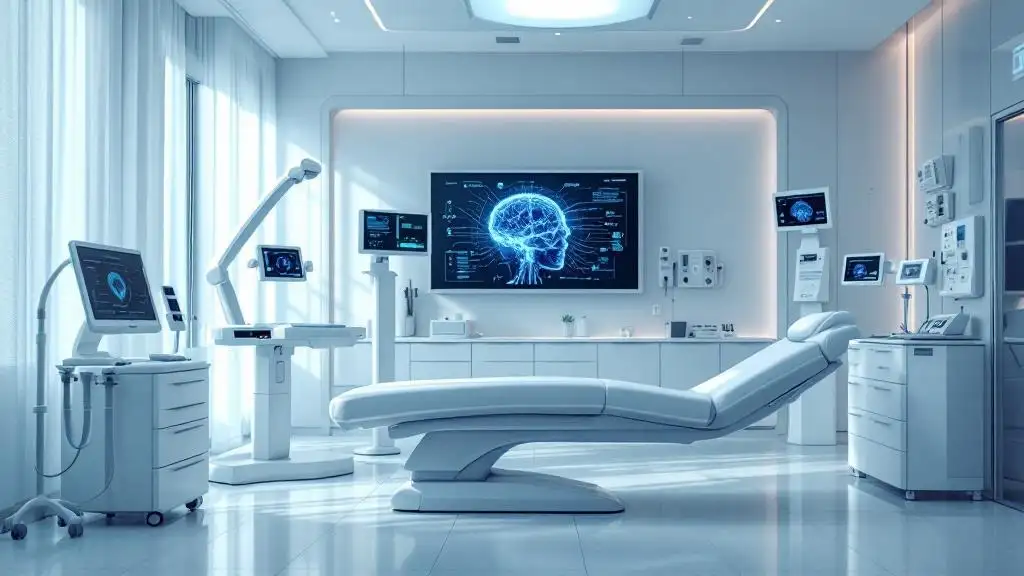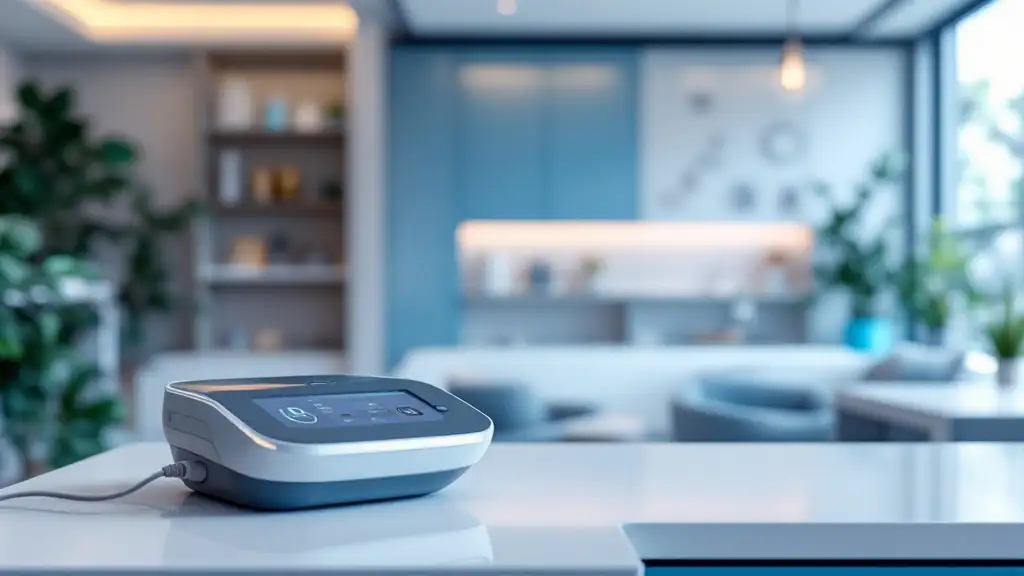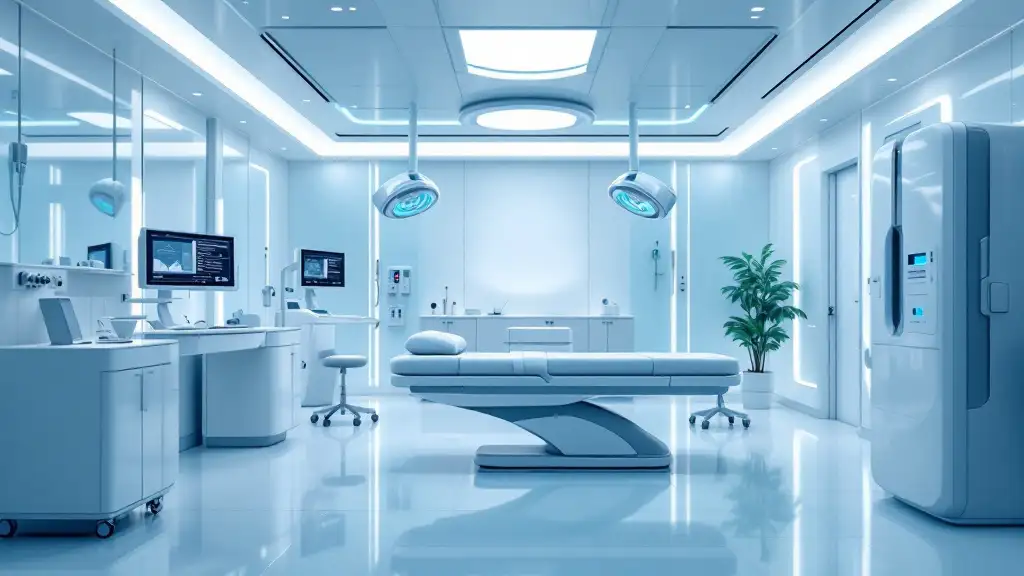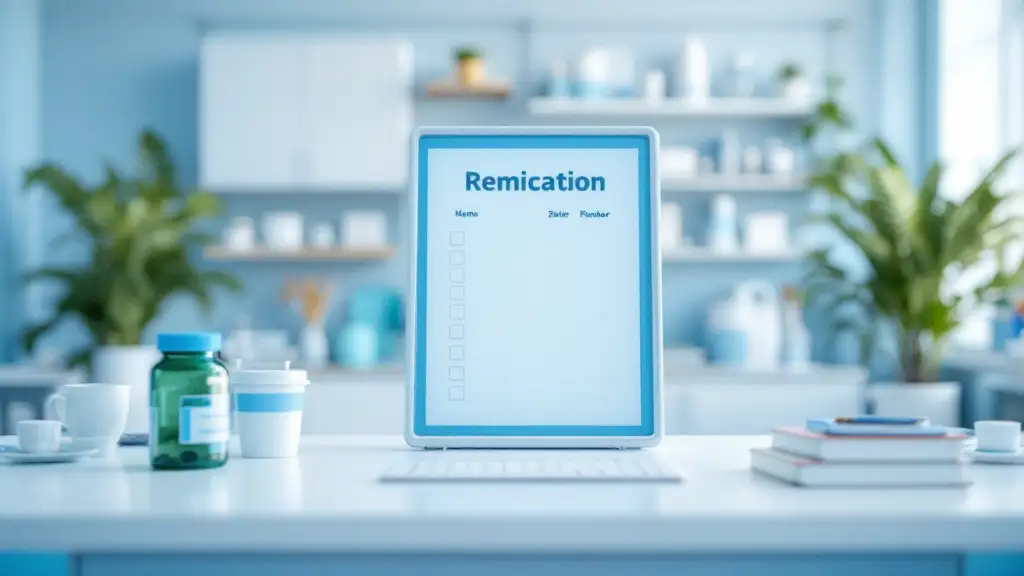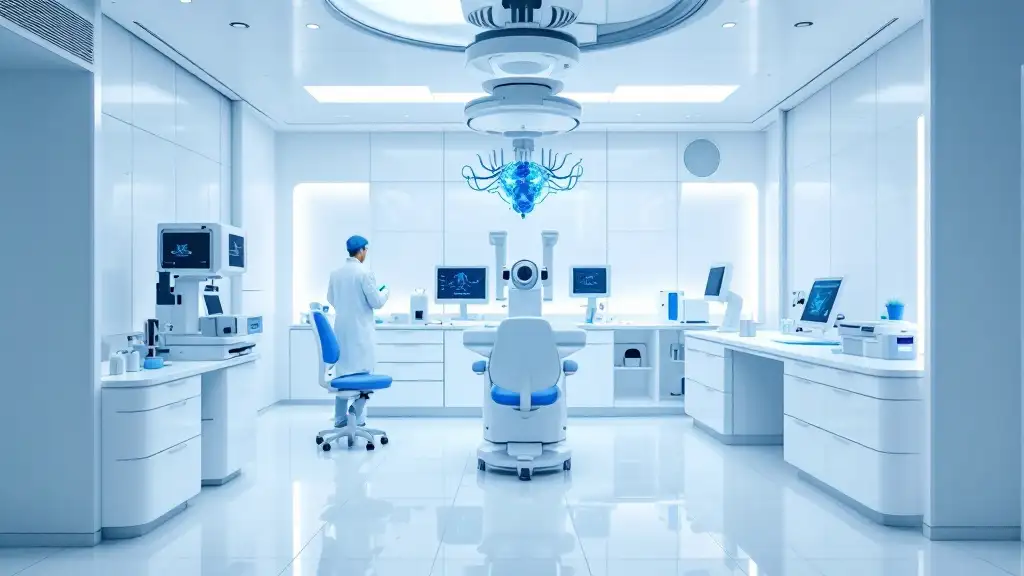Understanding Your Options for Managing Depression and Other Mental Conditions
Choosing the right treatment for mental health conditions like depression can be complex, with options ranging from biological interventions to talk-based therapies. This article explores the differences, benefits, limitations, and considerations when selecting between Transcranial Magnetic Stimulation (TMS) and talk therapy, helping you make informed decisions tailored to your needs.
Differing Mechanisms: How TMS and Talk Therapy Address Mental Health
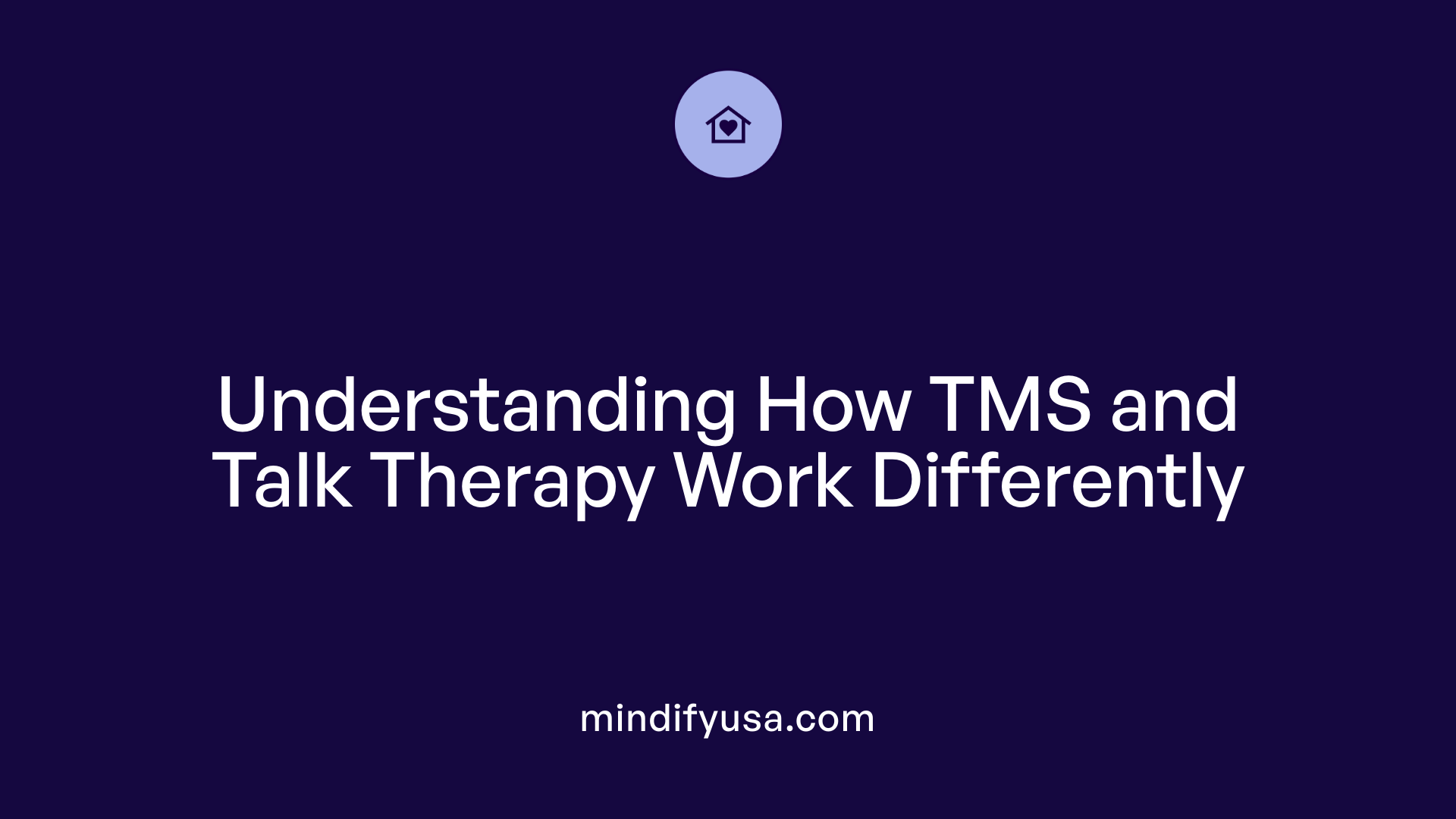
How do Transcranial Magnetic Stimulation (TMS) and talk therapy differ in their approaches to treating mental health conditions?
Transcranial Magnetic Stimulation (TMS) and talk therapy utilize fundamentally different methods to support mental health treatment. TMS is a modern, non-invasive technique that involves placing a device with electromagnetic coils on or near the scalp, delivering magnetic pulses to specific regions of the brain involved in mood regulation. This direct stimulation encourages underactive nerve cells to become more active, helping to reduce symptoms of depression, particularly in cases where medication or traditional therapy has not achieved desired results.
On the other hand, talk therapy, also known as psychotherapy, relies on dialogue between a person and a trained mental health professional. It explores thoughts, feelings, and behaviors, aiming to change negative patterns and develop healthier coping mechanisms. Approaches like Cognitive Behavioral Therapy (CBT) focus on restructuring negative thought patterns and emotional responses through active reflection and strategy development.
While TMS aims at biological repair by directly modulating brain activity, talk therapy emphasizes psychological understanding and emotional healing through conversation. Both methods can be used separately or in combination, addressing different facets of mental health. Combining them can provide a comprehensive treatment plan that targets both brain function and emotional well-being.
For individuals with treatment-resistant depression or those seeking non-drug options, TMS’s focus on biological changes offers an alternative, faster-acting approach. Conversely, talk therapy is often preferable for those interested in developing long-term coping skills, understanding personal challenges, and making psychological adjustments.
Ultimately, the choice between TMS and talk therapy depends on the severity of symptoms, previous treatment responses, and personal preferences. When used together, these therapies can complement each other, providing a holistic approach that tackles the biological roots and psychological factors of depression and other mental health conditions.
Understanding How TMS and Talk Therapy Work and Their Respective Benefits
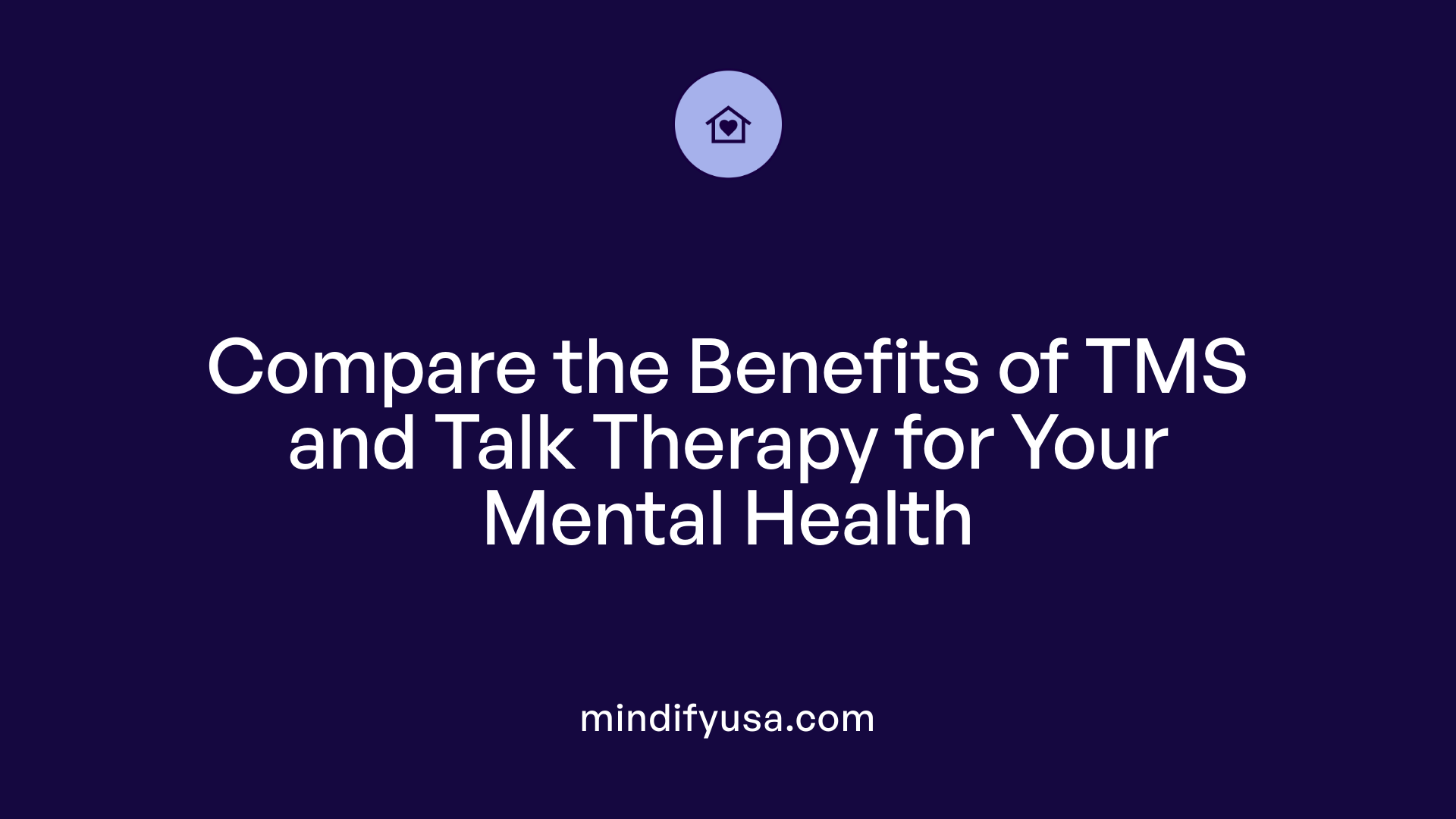
How do TMS and talk therapy work, and what are their respective advantages?
Transcranial magnetic stimulation (TMS) is a non-invasive medical procedure that actively stimulates specific areas of the brain responsible for mood regulation. During TMS sessions, a device with electromagnets is placed on the scalp, sending magnetic pulses to the targeted brain regions, such as the prefrontal cortex. This process encourages increased neural activity, helping to restore normal brain function and alleviate symptoms of depression. TMS is particularly beneficial for individuals with treatment-resistant depression who have not responded well to medication or talk therapy.
In contrast, talk therapy, also known as psychotherapy, involves engaging in structured conversations with a trained therapist. This approach explores thoughts, emotions, and behaviors to identify negative patterns and develop healthier coping strategies. Common forms include Cognitive Behavioral Therapy (CBT), which helps reshape harmful thought patterns, and other modalities that focus on emotional insight and personal growth.
The key advantage of TMS lies in its non-invasive, drug-free nature, making it suitable for those who experience side effects from medications. TMS sessions are quick, usually lasting about 20 to 40 minutes, and can produce relief within a few weeks. Its effectiveness for treatment-resistant depression and minimal side effects make it a promising option.
Talk therapy, on the other hand, provides long-term benefits by addressing psychological and behavioral challenges. It fosters emotional resilience and helps patients understand underlying issues that contribute to depression. Though it requires active participation and can take months to show full benefits, therapy promotes lasting change and emotional well-being.
Combining these methods offers a comprehensive approach: TMS targets biological deficiencies directly, while talk therapy addresses the psychological and emotional aspects. This integrated treatment can enhance overall outcomes, especially for those suffering from moderate to severe depression who have not found relief through medication alone.
In summary, TMS and talk therapy work differently but complement each other effectively. TMS stimulates the brain to improve neural activity, providing quick symptom relief, whereas talk therapy fosters emotional understanding and long-term coping skills. Together, they form a balanced treatment plan tailored to individual needs, maximizing the chances for recovery and improved quality of life.
Weighing the Benefits and Limitations of TMS Compared to Talk Therapy
 When considering treatment options for depression, it's important to understand how Transcranial Magnetic Stimulation (TMS) compares to talk therapy. Each approach has its strengths and limitations, making them suitable for different individuals based on their specific needs.
When considering treatment options for depression, it's important to understand how Transcranial Magnetic Stimulation (TMS) compares to talk therapy. Each approach has its strengths and limitations, making them suitable for different individuals based on their specific needs.
Evaluation of Effectiveness TMS offers a non-invasive, targeted solution that stimulates specific brain regions involved in mood regulation. It has been proven effective, especially for depression resistant to medication or other therapies, with over 100 clinical studies supporting its use. Patients often experience a noticeable improvement within 2-4 weeks of starting treatment. Talk therapy, such as Cognitive Behavioral Therapy (CBT), aims to change negative thought patterns and develop emotional coping skills. It can address a wide array of mental health issues, leading to long-term mental well-being, but may require several months before significant benefits become evident.
Speed of Results One significant advantage of TMS is its relatively rapid action. Many patients see symptom relief within a few weeks, which is especially crucial for severe depression. Talk therapy typically takes longer; improvements often arise gradually over multiple months due to the process of exploring thoughts and practicing new emotional responses.
Physical and Emotional Side Effects and Limitations TMS is generally well-tolerated, with minor side effects such as mild headaches or scalp discomfort, and it’s drug-free. However, it isn't suitable for individuals with metal implants or seizure disorders. Its higher cost and time commitment—sessions usually last around 20-40 minutes daily over several weeks—can also be barriers.
In contrast, talk therapy has no physical side effects and can be adapted to individual preferences. It requires emotional openness, active participation, and a significant time commitment, often weekly sessions over months or years. While effective, it may be less suitable for those with severe depression or neurobiological conditions that impair emotional regulation.
Summary in a Comparative Table
| Aspect | TMS | Talk Therapy | Additional Details |
|---|---|---|---|
| Effectiveness | Proven for treatment-resistant depression | Effective for mild to moderate depression | TMS physically stimulates brain; therapy addresses thought/emotional patterns |
| Speed of Results | Usually within 2-4 weeks | Often takes several months | TMS offers faster relief, while therapy builds long-term skills |
| Side Effects | Mild headaches, scalp discomfort, drug-free | No physical side effects | TMS contraindicated with metal implants; therapy requires emotional effort |
| Duration & Cost | 4-6 weeks, daily sessions, $6,000-$12,000 | Weeks or months, weekly sessions, cost varies | TMS has higher upfront costs; therapy involves ongoing time investment |
| Suitability | Resistant depression, medication avoidance | Mild to moderate depression, emotional skill building | Choice depends on depression severity, personal preferences |
Ultimately, combining TMS and talk therapy can address both the biological and psychological facets of depression, providing a comprehensive approach. The decision should involve a healthcare professional who can evaluate individual conditions, previous treatment responses, and personal preferences to determine the most effective plan.
Assessing Suitability: When to Choose TMS or Talk Therapy
How can I determine whether TMS or talk therapy is more suitable for my mental health condition?
Deciding between TMS and talk therapy largely depends on your depression's severity, your previous treatment responses, and your personal preferences.
TMS, or Transcranial Magnetic Stimulation, is often recommended for individuals with treatment-resistant depression—when medications and talk therapy haven't provided sufficient relief. It works directly on specific brain regions involved in mood regulation, often delivering faster results—sometimes within a few weeks. Because it is non-invasive and drug-free, TMS can be a good option for those who experience side effects from medications or prefer a modern, medical approach.
Talk therapy, especially cognitive-behavioral therapy (CBT), is usually preferred for mild to moderate depression. It involves working with a therapist through regular conversations aimed at understanding thoughts, emotions, and behaviors. This form of therapy helps build coping skills, address negative thought patterns, and often requires a longer-term commitment—sometimes over several months or years.
For many patients, a combined approach offers optimal benefits. TMS can reduce symptoms biologically, making it easier for individuals to engage actively in talk therapy. Conversely, therapy can help address psychological aspects that TMS does not target.
Ultimately, a healthcare professional will evaluate your unique case and recommend the most appropriate treatment plan. Factors such as the urgency of symptom relief, treatment history, and lifestyle considerations all play a part in this decision.
Is there a way to identify which treatment might work best for my specific needs?
A personalized assessment by a mental health specialist is crucial. They will consider your clinical history, severity of depression, physical health status, and personal treatment preferences. This tailored approach helps ensure you receive the most effective and sustainable care.
For further guidance, searching with the query "Guidelines for selecting TMS or talk therapy based on condition severity and response" can provide valuable resources and clinical recommendations tailored to different depression profiles.
Criteria and Factors Influencing Treatment Choice
What criteria should I consider when selecting a mental health treatment such as TMS or talk therapy?
Choosing between TMS therapy and talk therapy involves evaluating several important factors to find the most suitable approach for your needs.
First, consider your diagnosis and the severity of your symptoms. TMS is often recommended for those with treatment-resistant depression, where other treatments like medication or talk therapy haven't provided sufficient relief. For milder or moderate depression, talk therapy, especially cognitive-behavioral therapy (CBT), is frequently effective.
Your treatment history also matters. If you have already tried medications without success or cannot tolerate their side effects, TMS might be a better option. Conversely, if you prefer a non-medical, conversational approach or wish to develop emotional skills and coping strategies, talk therapy could be suitable.
Lifestyle constraints should also be considered. TMS requires daily clinic visits over several weeks, which may be challenging for some individuals due to work, family, or transportation issues. Talk therapy often involves weekly sessions lasting about an hour, allowing more flexibility for some.
Personal preferences and comfort are key. Some individuals may prefer TMS because it is non-invasive, involves no medication, and generally causes fewer physical side effects. Others might value the active engagement and emotional insight offered by talk therapy.
Finally, consulting with a healthcare professional can guide you through the decision-making process. They can assess your specific condition, discuss treatment options, and help you understand the potential benefits, risks, and commitments associated with each approach.
| Criteria | TMS Therapy | Talk Therapy | Why It Matters |
|---|---|---|---|
| Diagnosis considerations | Effective for treatment-resistant depression | Suitable for mild to moderate depression | Ensures treatment matches severity and type of condition |
| Symptom severity | Severe or resistant depression | Mild to moderate depression | Guides appropriate choice based on symptom level |
| Lifestyle constraints | Daily sessions over 4-6 weeks, time commitment needed | Weekly or biweekly sessions, more flexible schedule | Affects feasibility and adherence |
| Personal preferences | Prefer non-invasive, drug-free options | Interested in talk-based, emotional insight-focused therapy | Ensures comfort and engagement with treatment |
Making an informed decision by considering these factors enhances the likelihood of a successful outcome. Remember, combining treatments like TMS with talk therapy can also provide a comprehensive approach to managing depression effectively.
Positioning TMS in the Broader Spectrum of Depression Treatments
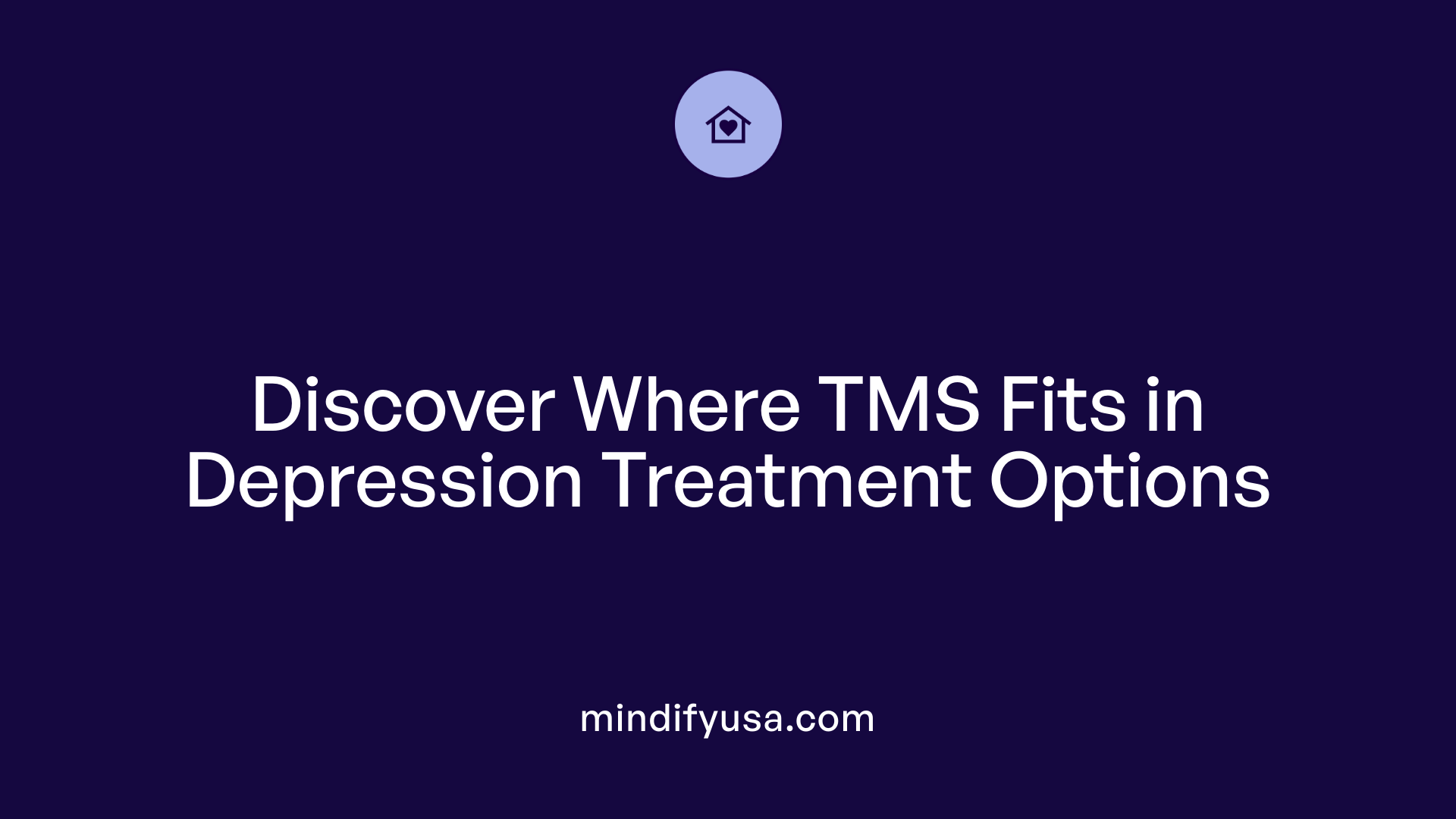 When considering treatments for depression, TMS (transcranial magnetic stimulation) stands out as a modern, non-invasive option that complements traditional approaches like medication and talk therapy. Its unique mechanism involves delivering magnetic pulses to stimulate underactive brain regions associated with mood regulation, offering a different pathway to relief.
When considering treatments for depression, TMS (transcranial magnetic stimulation) stands out as a modern, non-invasive option that complements traditional approaches like medication and talk therapy. Its unique mechanism involves delivering magnetic pulses to stimulate underactive brain regions associated with mood regulation, offering a different pathway to relief.
Compared with medication therapy, which typically involves antidepressants such as SSRIs and SNRIs, TMS acts directly on specific brain areas, leading to faster symptom improvement in many cases. While medications may take 4 to 6 weeks to show full effects and can cause side effects like nausea, weight gain, or sexual dysfunction, TMS often provides noticeable relief within 2 to 4 weeks without systemic side effects. Additionally, TMS does not require daily pill intake, making it a suitable choice for those seeking a drug-free alternative.
Electroconvulsive therapy (ECT), another invasive option, has a larger impact on severe depression but involves general anesthesia and carries risks such as memory loss. In contrast, TMS is less invasive, generally painless, and has a lower risk profile, making it a more acceptable treatment for many patients.
Response and remission rates further highlight TMS’s effectiveness. Clinical studies show that about 60% of patients respond to TMS, with close to 78.6% achieving remission—numbers that demonstrate its potential for meaningful symptom reduction. For context, talk therapy like Cognitive Behavioral Therapy (CBT) has response rates ranging from 61% to 87%, and medication therapies show remission rates around 35%. Compared to these, TMS offers a promising middle ground with rapid action and high success rates.
Overall, TMS provides an effective approach especially for those who have not benefited from traditional treatments or cannot tolerate medication side effects. Its ability to produce quick improvements, combined with its safety profile, makes it a valuable addition to the spectrum of depression therapies. Often, the best outcomes occur by combining TMS with talk therapy, addressing biological and psychological factors to enhance recovery.
| Treatment Method | Response Rate | Remission Rate | Duration and Approach | Side Effects |
|---|---|---|---|---|
| TMS | ~60% | ~78.6% | Daily sessions over 4-6 weeks, 20-40 mins each | Minimal, mainly discomfort |
| Medication (SSRIs, SNRIs) | Variable, ~35% | N/A | Daily pills, often for months or years | Nausea, weight changes, sleep issues |
| Talk Therapy (CBT, others) | 61-87% | N/A | Weekly sessions over months or years | Emotional effort required |
| Electroconvulsive Therapy (ECT) | N/A | N/A | Few sessions, more invasive | Memory loss, headache |
Choosing the appropriate treatment depends on the individual's condition, treatment history, and personal preferences. Combining therapies, such as TMS with talk therapy, can harness the strengths of each, leading to better, more sustained improvements in managing depression.
Educational Resources to Empower Your Mental Health Decisions
 Understanding mental health treatment options can sometimes feel overwhelming, but several credible resources are available to help you make informed decisions.
Understanding mental health treatment options can sometimes feel overwhelming, but several credible resources are available to help you make informed decisions.
Reputable organizations such as the National Institute of Mental Health (NIMH), the CDC, and SAMHSA provide accessible educational materials. These include videos, brochures, fact sheets, and interactive tools designed for different age groups and levels of understanding. These resources can explain various treatments like TMS therapy and talk therapy, helping you understand how they work and their benefits.
Online directories like FindSupport.gov, the American Psychiatric Association, and Mental Health America serve as valuable tools for locating qualified mental health providers and support services.
Engaging with organizations such as NAMI offers additional opportunities for learning through educational classes, seminars, and peer-led support groups, which can deepen your understanding of mental health conditions and treatment options.
For immediate assistance and reliable information, crisis helplines such as the 988 Suicide & Crisis Lifeline and the Crisis Text Line are important resources.
Furthermore, consulting evidence-based treatment guidelines and manuals from sources like the Evidence-Based Practices Resource Center provides in-depth insights into proven approaches for managing mental health conditions, including medication, therapy, and innovative treatments like TMS.
Exploring these educational resources equips you with knowledge and support, empowering you to actively participate in your mental health care decisions.
| Resource Type | Examples | Purpose |
|---|---|---|
| Government agencies | NIMH, CDC, SAMHSA | Provide educational materials and guidelines |
| Support organizations | NAMI, Mental Health America | Offer classes, seminars, and community support |
| Online directories | FindSupport.gov, APA | Help locate mental health professionals |
| Crisis helplines | 988 Lifeline, Crisis Text Line | Offer immediate help and information |
| Educational guidelines | Evidence-Based Practices Resource Center | In-depth treatment information |
Accessing these trusted sources can greatly enhance your understanding of mental health treatments like TMS and talk therapy, enabling you to choose the best path for your well-being.
Making the Right Choice for Your Mental Wellbeing
Choosing between TMS and talk therapy requires careful consideration of your specific condition, personal preferences, and treatment goals. Consulting with healthcare professionals can help determine the optimal combination or sequence of treatments, whether aiming for rapid symptom relief or long-term emotional growth. Ultimately, informed decision-making empowers you to select the most suitable approach, paving the way for lasting mental health and improved quality of life.
References
- TMS Therapy vs. Talk Therapy: How They Work Together
- Comparing Treatment Options: Traditional Therapy vs TMS
- Therapy or TMS Treatment? How to Choose the Right Treatment
- How Does TMS Therapy Compare to Talk Therapy?
- TMS Therapy vs. Traditional Medication Therapy: Which Is ...
- TMS Therapy, Medication, and Talk ...
- Resources for Students and Educators
- Mental Health Resources
- Mental Health Education











